Link Analysis_2_Application
US Cities Distribution Network
1.1 Task Description
Nodes: Cities with attributes (1) location, (2) population;
%matplotlib notebook
import networkx as nx
import matplotlib.pyplot as plt
G = nx.read_gpickle('major_us_cities')
G.nodes(data=True)
[('El Paso, TX', {'location': (-106, 31), 'population': 674433}),
('Long Beach, CA', {'location': (-118, 33), 'population': 469428}),
('Dallas, TX', {'location': (-96, 32), 'population': 1257676}),
('Oakland, CA', {'location': (-122, 37), 'population': 406253}),
('Albuquerque, NM', {'location': (-106, 35), 'population': 556495}),
('Baltimore, MD', {'location': (-76, 39), 'population': 622104}),
('Raleigh, NC', {'location': (-78, 35), 'population': 431746}),
('Mesa, AZ', {'location': (-111, 33), 'population': 457587}),
('Arlington, TX', {'location': (-97, 32), 'population': 379577}),
('Sacramento, CA', {'location': (-121, 38), 'population': 479686}),
('Wichita, KS', {'location': (-97, 37), 'population': 386552}),
('Tucson, AZ', {'location': (-110, 32), 'population': 526116}),
('Cleveland, OH', {'location': (-81, 41), 'population': 390113}),
('Louisville/Jefferson County, KY',
{'location': (-85, 38), 'population': 609893}),
('San Jose, CA', {'location': (-121, 37), 'population': 998537}),
('Oklahoma City, OK', {'location': (-97, 35), 'population': 610613}),
('Atlanta, GA', {'location': (-84, 33), 'population': 447841}),
('New Orleans, LA', {'location': (-90, 29), 'population': 378715}),
('Miami, FL', {'location': (-80, 25), 'population': 417650}),
('Fresno, CA', {'location': (-119, 36), 'population': 509924}),
('Philadelphia, PA', {'location': (-75, 39), 'population': 1553165}),
('Houston, TX', {'location': (-95, 29), 'population': 2195914}),
('Boston, MA', {'location': (-71, 42), 'population': 645966}),
('Kansas City, MO', {'location': (-94, 39), 'population': 467007}),
('San Diego, CA', {'location': (-117, 32), 'population': 1355896}),
('Chicago, IL', {'location': (-87, 41), 'population': 2718782}),
('Charlotte, NC', {'location': (-80, 35), 'population': 792862}),
('Washington D.C.', {'location': (-77, 38), 'population': 646449}),
('San Antonio, TX', {'location': (-98, 29), 'population': 1409019}),
('Phoenix, AZ', {'location': (-112, 33), 'population': 1513367}),
('San Francisco, CA', {'location': (-122, 37), 'population': 837442}),
('Memphis, TN', {'location': (-90, 35), 'population': 653450}),
('Los Angeles, CA', {'location': (-118, 34), 'population': 3884307}),
('New York, NY', {'location': (-74, 40), 'population': 8405837}),
('Denver, CO', {'location': (-104, 39), 'population': 649495}),
('Omaha, NE', {'location': (-95, 41), 'population': 434353}),
('Seattle, WA', {'location': (-122, 47), 'population': 652405}),
('Portland, OR', {'location': (-122, 45), 'population': 609456}),
('Tulsa, OK', {'location': (-95, 36), 'population': 398121}),
('Austin, TX', {'location': (-97, 30), 'population': 885400}),
('Minneapolis, MN', {'location': (-93, 44), 'population': 400070}),
('Colorado Springs, CO', {'location': (-104, 38), 'population': 439886}),
('Fort Worth, TX', {'location': (-97, 32), 'population': 792727}),
('Indianapolis, IN', {'location': (-86, 39), 'population': 843393}),
('Las Vegas, NV', {'location': (-115, 36), 'population': 603488}),
('Detroit, MI', {'location': (-83, 42), 'population': 688701}),
('Nashville-Davidson, TN', {'location': (-86, 36), 'population': 634464}),
('Milwaukee, WI', {'location': (-87, 43), 'population': 599164}),
('Columbus, OH', {'location': (-82, 39), 'population': 822553}),
('Virginia Beach, VA', {'location': (-75, 36), 'population': 448479}),
('Jacksonville, FL', {'location': (-81, 30), 'population': 842583})]
1.2 Create Layouts for Plotting
Dictionary for node positioning methods:
[x for x in nx.__dir__() if x.endswith('_layout')]
['circular_layout', 'random_layout', 'shell_layout', 'spring_layout', 'spectral_layout', 'fruchterman_reingold_layout']
1.2.1 Spring Layout (default) Node Positioning: (1) As few crossing edges as possible; (2) Keep edge length similar.
plt.figure(figsize=(10,9))
nx.draw_networkx(G)
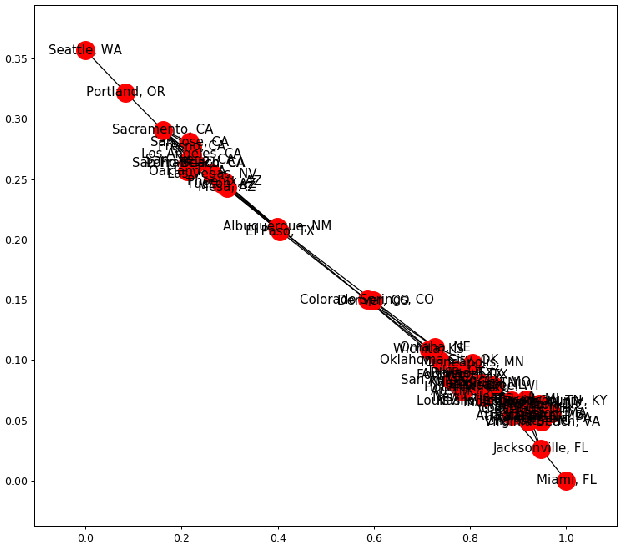
1.2.2 Random Layout
plt.figure(figsize=(10,9)) pos = nx.random_layout(G) nx.draw_networkx(G, pos)
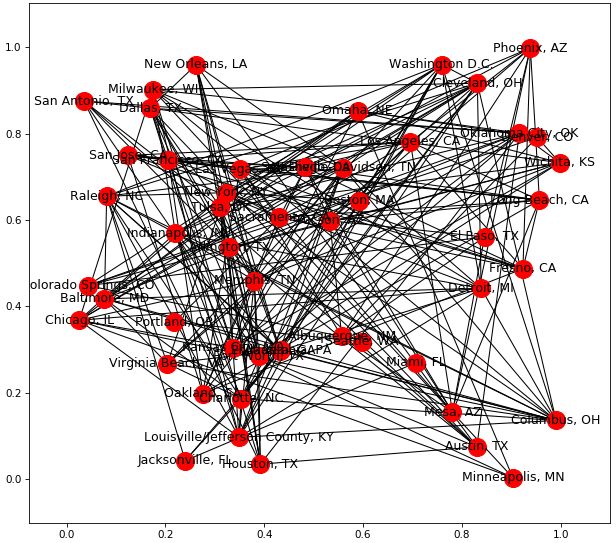
1.2.3 Cicular Layout
plt.figure(figsize=(10,9)) pos = nx.circular_layout(G) nx.draw_networkx(G, pos)
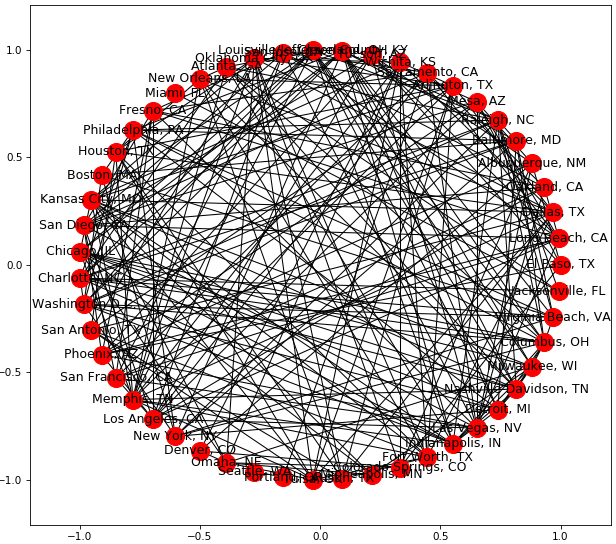
1.2.4 Custom Layout
plt.figure(figsize=(10,7)) pos = nx.get_node_attributes(G, 'location') nx.draw_networkx(G, pos)

plt.figure(figsize=(10,7)) nx.draw_networkx(G, pos, alpha=0.7, with_labels=False, edge_color='.4') plt.axis('off') plt.tight_layout();
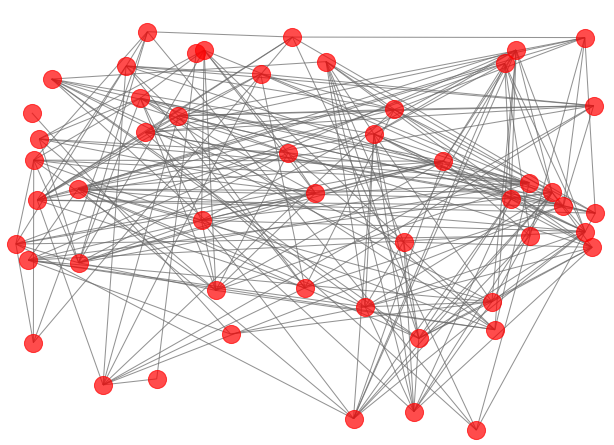
Set size of nodes based on population, multiply pop with small number so plots won't be large.
Get weights of transportation costs and pass it to edges.
plt.figure(figsize=(10,7)) node_color = [G.degree(v) for v in G] node_size = [0.0005 * nx.get_node_attributes(G, 'population')[v] for v in G] edge_width = [0.0015*G[u][v]['weight'] for u,v in G.edges()] nx.draw_networkx(G, pos, node_size=node_size, node_color=node_color, alpha=0.7, with_labels=False, width=edge_width, edge_color='.4', cmap=plt.cm.Blues) plt.axis('off') plt.tight_layout();

Display the most expensive costs, i.e., separately add specific labels and edges.
plt.figure(figsize=(10,7)) node_color = [G.degree(v) for v in G] node_size = [0.0005*nx.get_node_attributes(G, 'population')[v] for v in G] edge_width = [0.0015*G[u][v]['weight'] for u,v in G.edges()] nx.draw_networkx(G, pos, node_size=node_size, node_color=node_color, alpha=0.7, with_labels=False, width=edge_width, edge_color='.4', cmap=plt.cm.Blues) greater_than_770 = [x for x in G.edges(data=True) if x[2]['weight']>770] nx.draw_networkx_edges(G, pos, edgelist=greater_than_770, edge_color='r', alpha=0.4, width=6) nx.draw_networkx_labels(G, pos, labels={'Los Angeles, CA': 'LA', 'New York, NY': 'NYC'}, font_size=18, font_color='w') plt.axis('off') plt.tight_layout();
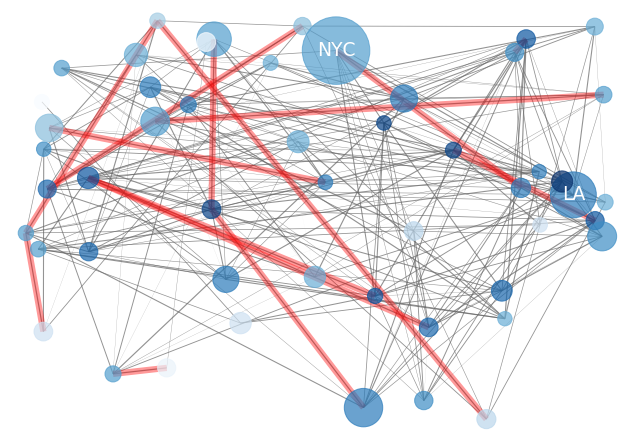
1.3 Degree Distribution
Probability distributions over entire network
# function degree() returns a dictionary with keys being nodes and # values being degrees of nodes degrees = G.degree() degree_values = sorted(set(degrees.values())) histogram = [list(degrees.values()).count(i)/float(nx.number_of_nodes(G)) for i in degree_values] import matplotlib.pyplot as plt plt.bar(degree_values, histogram) plt.xlabel('Degree') plt.ylabel('Fraction of Nodes') plt.show()
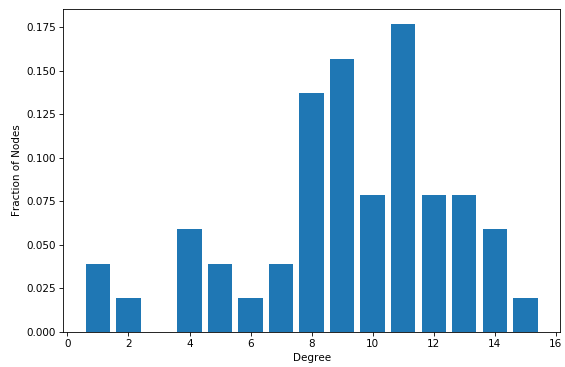
1.4 Extracting Attributes
1.4.1 Node-based Method
Transform into DataFrame columns, initialize the dataframe, using the nodes as the index:
df = pd.DataFrame(index = G.nodes())
df['location'] = pd.Series(nx.get_node_attributes(G, 'location')) df['population'] = pd.Series(nx.get_node_attributes(G, 'population')) df.head()

Add features:
df['clustering'] = pd.Series(nx.clustering(G)) df['degree'] = pd.Series(G.degree()) df
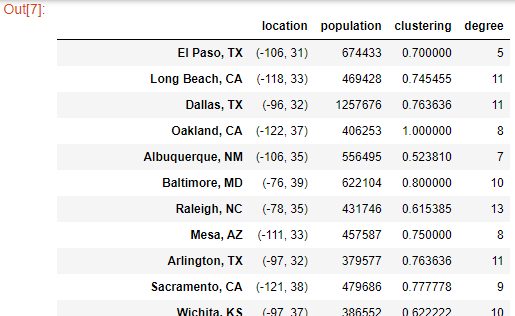
1.4.2 Edge-based Features
Initialize the DataFrame, using the edges as the index:
G.edges(data=True) df = pd.DataFrame(index=G.edges()) df['weight'] = pd.Series(nx.get_edge_attributes(G, 'weight')) df
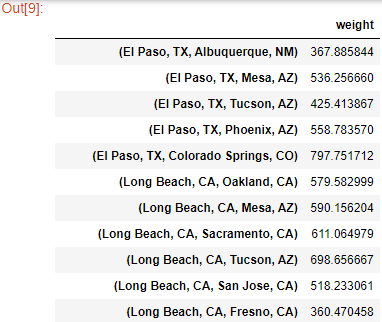
df['preferential attachment'] = [i[2] for i in nx.preferential_attachment(G, df.index)] df['Common Neighbors'] = df.index.map(lambda city: len(list(nx.common_neighbors(G, city[0], city[1])))) df
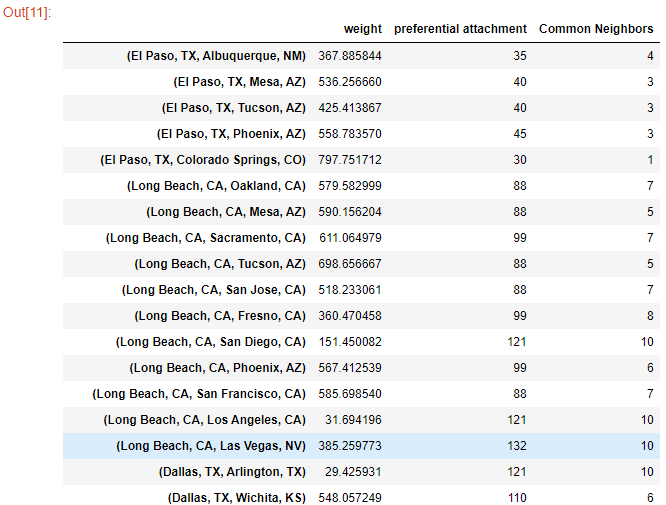



 浙公网安备 33010602011771号
浙公网安备 33010602011771号